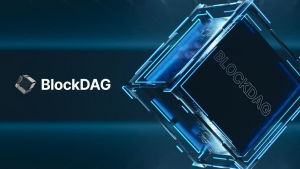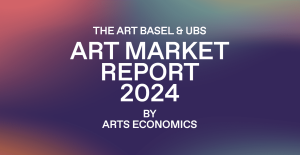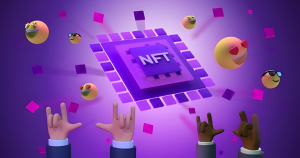What are NFT Apps? How to Create NFT DApps and launch them?

[ad_1]
Discover the rapidly growing world of NFT DApps – decentralized, blockchain powered apps that are transforming digital ownership and creative monetization.
The combination of NFTs with DApps creates a dynamic ecosystem which offers cutting-edge solutions for a variety of industries. This is achieved by bringing together digital ownership, decentralized finances, and programmable asset.
NFTs and DApps converge
Two key elements of the blockchain ecosystem are non-fungible (NFT) tokens and decentralized (DApp) apps. They may serve different purposes but there are some situations where they complement each other.
NFTs are a great way to represent ownership and access rights in DApps. DApps can tokenize items such as digital art, real-estate, and ingame assets by using NFT standards, like ERC-721 or ERC-1155.
In gaming DApps the NFTs represent in-game assets. The fact that these assets are available for purchase and trade on secondary markets enhances the concept and interoperability of virtual worlds and videogames.
The development of NFTs also led to the popularity and proliferation of DApps that are designed specifically for the creation, exchange, and management of digital assets. Through the tokenization process, artists and content producers can create a unique digital product that customers can purchase, sell, or possess. Creators are now able to interact directly with their audience, as collectors have a reliable and secure way to acquire digital assets.
What are NFT Digital Apps?
NFT DApps is a blockchain-based application that uses non-fungible tokens. These apps allow users to create, buy, trade, and sell unique digital products such as artwork, collectibles, or in-game items. NFT DApps empower content creators, artists, and gamers by transforming ownership using blockchain technology.
NFT DApps have a lot of value because they provide a decentralized marketplace, encourage peer-topeer trade, offer novel ownership structures, disrupt traditional industries, and allow people to easily participate in the global digital market.
Why NFT DApps?
They are unique because they are not governed solely by a single entity. This means that they are more open and safer. They allow artists, creators and gamers to share their works in a unique manner that makes each piece of work one-of a-kind.
Types of NFT DApps
NFT DApps encompass a wide range of platforms, all of which are designed to address specific aspects of the digital and blockchain landscape.
Platforms for art and collectibles
To facilitate the trading and buying of their digital assets, artists tokenize them as NFTs using websites such as OpenSea or Rarible. These platforms act as hubs of the digital art market, allowing artists to claim their value within the blockchain ecosystem.
Gaming and virtual worlds
DApps such as CryptoKitties or Decentraland use NFTs to represent objects, characters or stuff in-game. The ability to buy, sell, and trade these assets creates a robust virtual economic system. The convergence of blockchain and gaming has led to the development of innovative ideas, such as play-to-earn. This allows players to make money through playing games based upon blockchain technology.
Virtual real estate
Virtual real estate platforms give NFTs a unique perspective. Users can profit from their virtual property, as well as buy, sell, and trade virtual land. This innovative idea has raised the possibility of a whole new era in digital property rights, and has sparked an interest in user-owned decentralized virtual worlds.
Market Places
The NFT eco-system relies heavily on marketplaces, such as Foundation and Mintable. They give creators the tools to mint NFTs for distribution to a worldwide audience. These platforms serve as middlemen, connecting fans with artists and promoting the growth of NFTs.
How to create and launch a NFT DApp
The following steps will guide you through the process of creating an NFT DApp.
1. Define the concept
Before beginning development, the team should clearly define the concept of the NFT DApp. This includes defining the DApp’s objective, its target audience, and its unique selling points.
2. Choose the blockchain
It is essential to choose the right blockchain platform when creating an NFT-based DApp. Ethereum is a popular choice because of its well-established platform and support for NFT standard like ERC-721 or ERC-1155. BNB Smart Chain or other blockchain systems may be considered, depending on the requirements of the project.
3. Enhance the environment for development
Install the required tools and dependencies to set up the development environment. Install the necessary tools and dependencies to set up the development environment.
4. Smart contracts
Create smart contracts which will control NFT distribution, creation, and ownership. These contracts specify conditions and characteristics such as minting and buying of NFTs.
5. Integrate a wallet
Integrate wallets, so that users can manage their NFTs securely. This means establishing a connection with wallets, such as MetaMask Wallet or Trust Wallet, to allow users to interact directly with the DApp via their crypto wallets.
6. Implement minting functionality
The minting feature is needed to allow creators to tokenize assets with NFTs. The user interface must be easy to use for creators and artist so that they can upload creations, add details, and mint the NFTs.
Include functionality for buying, trading, and selling NFTs if the NFT App has a market. Implement functionalities such as bidding, auctioning and real-time changes in price.
Users should be able to easily search, buy and sell NFTs with an engaging and user friendly interface. Add features such as search, filters, a user-friendly wallet, and an engaging interface.
7. Test thoroughly and deploy the NFT DApp on the blockchain
Before releasing the NFT DApp on the blockchain, ensure that it has been thoroughly tested to identify any bugs or vulnerabilities. Once you are satisfied, upload the data and smart contracts to the blockchain of your choice. To make the NFT DApp globally accessible, it is necessary to interact with the blockchain.
8. Launch and marketing
A well-planned strategic plan is essential to generating interest and ensuring a successful launch of an NFT DApp. Start by distributing smart contracts that have been carefully designed throughout the mainnet to formally introduce the NFT DApp. At the same, develop a comprehensive plan for marketing to increase visibility.
Create an engaging story that highlights the unique selling point for the NFT DApp. Distribute it through online forums, social media channels and cryptocurrency communities. Connect with thought leaders and influential people within the NFT sector in order to expand your following and establish a reputation.
Conclusion
NFT DApps represent a unique combination between creativity, technology, and innovation. To create one, you need to have a good understanding of blockchain and some technological knowledge. As this technology advances, future NFT-based DApps may become more creative and amazing.
[ad_2]




